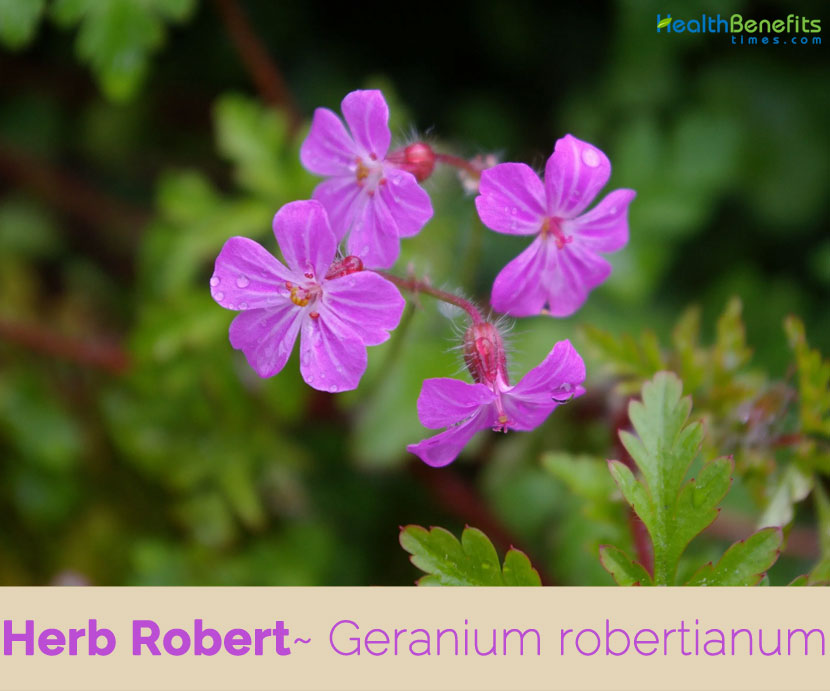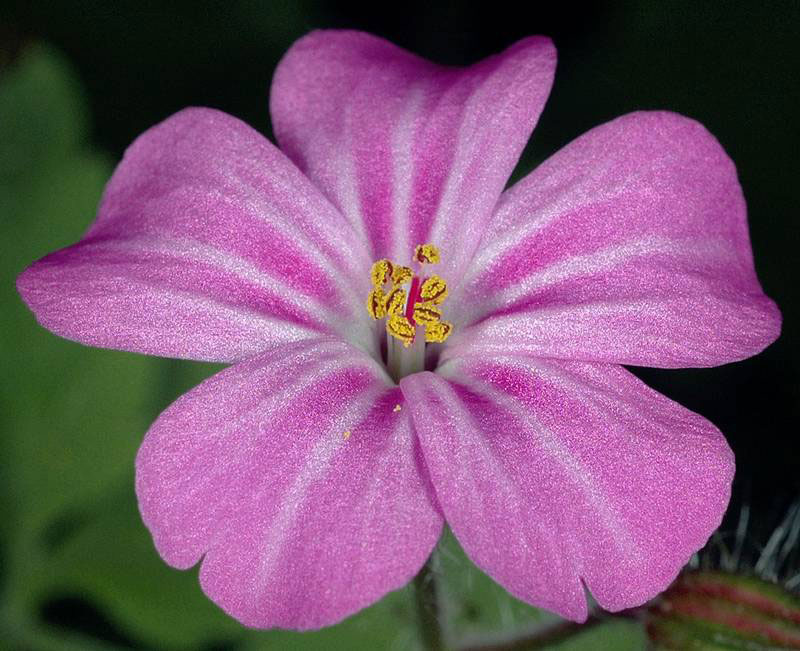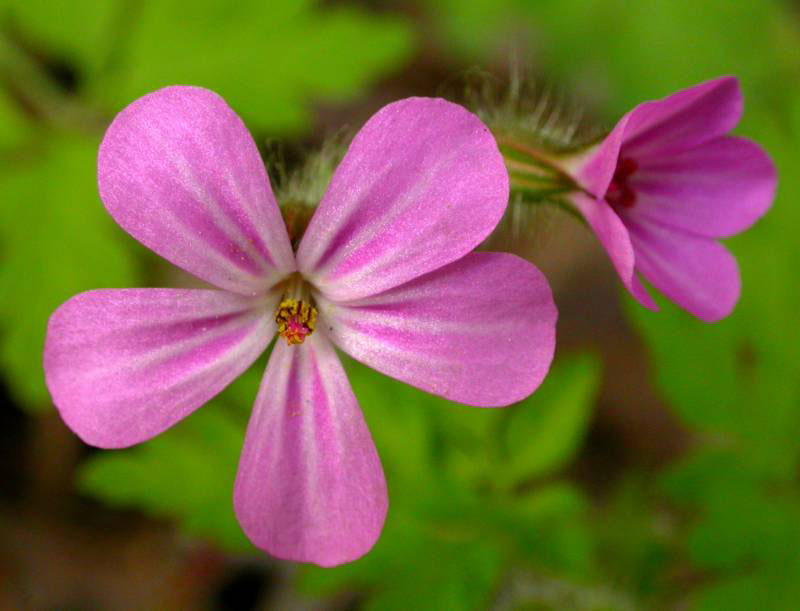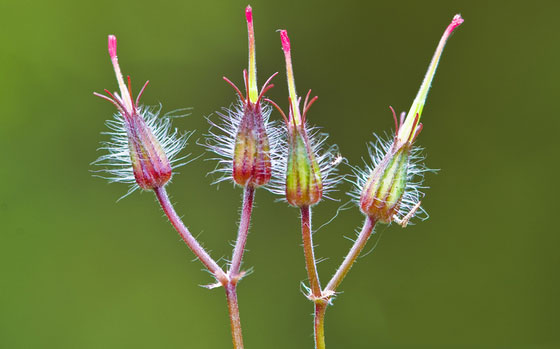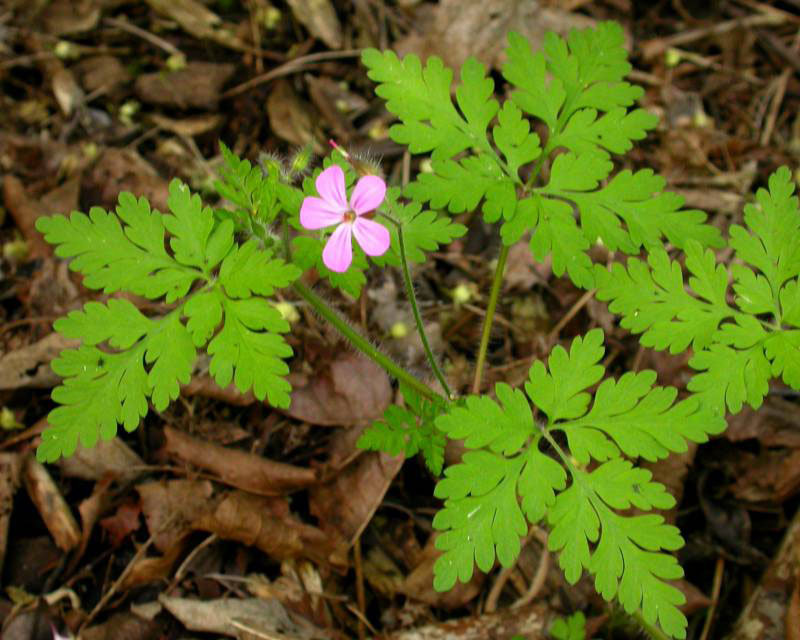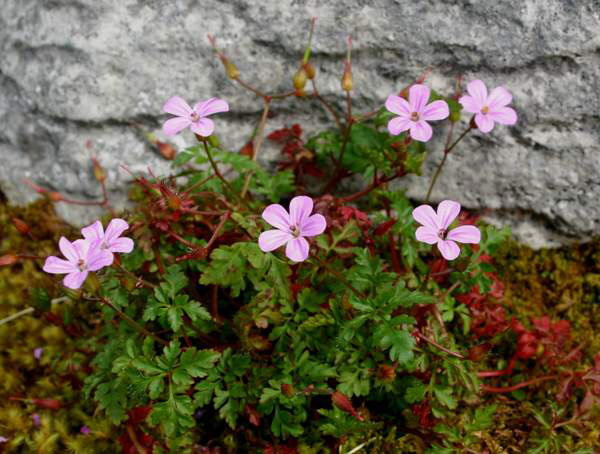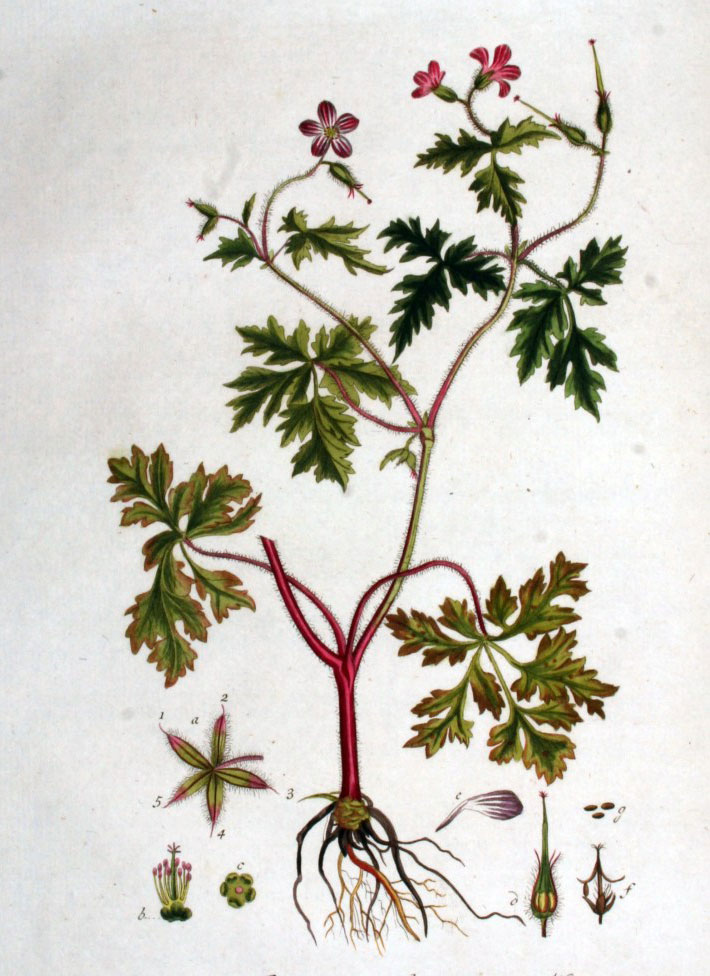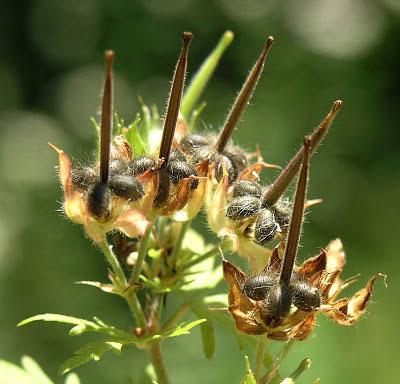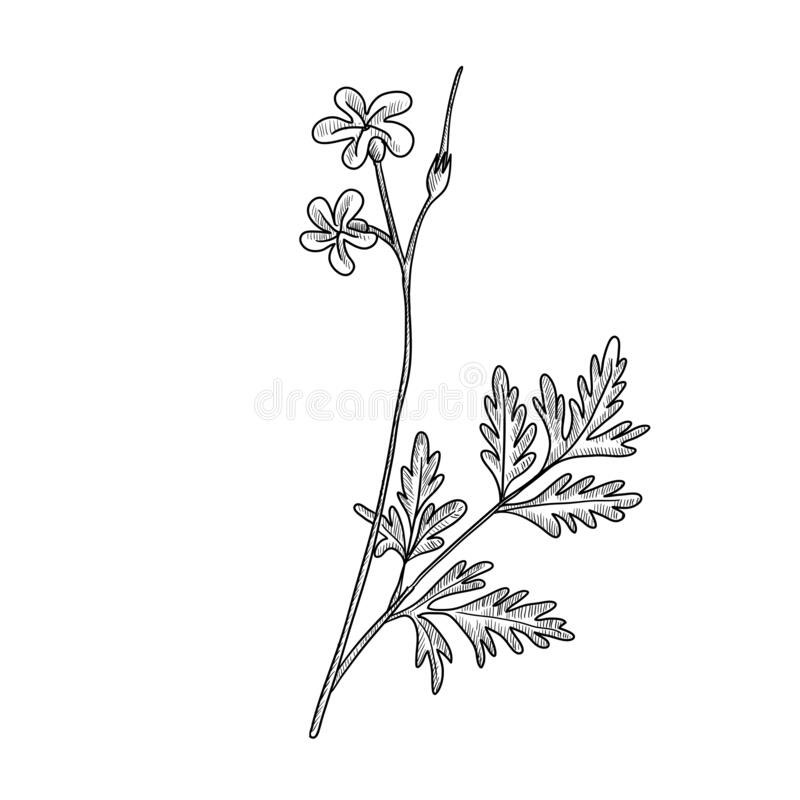| Herb Robert Quick Facts | |
|---|---|
| Name: | Herb Robert |
| Scientific Name: | Geranium robertianum |
| Origin | Europe and parts of Asia, North America, and North Africa |
| Shapes | Carpels, 5-parted, short-hairy at the tips; styles 15-25 mm long, beaks 6-7 mm long |
| Health benefits | Reduces Inflammation, Foot soak, Blood clotting effect, Oxygen enhancer, Antibacterial Properties, Menopause, Boosts Immunity, Kidney Health, Respiratory health, Relieves Pain, Digestive health, Stress & Anxiety |
| Name | Herb Robert |
|---|---|
| Scientific Name | Geranium robertianum |
| Native | Central Europe, Mediterranean and Asia. It is common in Europe, with the exception of the far north, in temperate parts of Asia, North Africa, the Atlantic area of North America, and temperate parts of South America |
| Common Names | Herb-Robert, red robin, death come quickly, storksbill, fox geranium, stinking Bob, squinter-pip, crow’s foot, Roberts geranium, bloodwort, cranesbill, felonwort, St. Robert, St. Robert’s Wort, Dragon’s blood, Beak Stork, Red Grass, Devil’s Fork, Geranion, Pin of the Virgin, Our Lady Needle, Foot pigeon foot dove, wild chervil, grass Saint Robert , mosquito parsley Robertin, gériane |
| Name in Other Languages | Albanian: Kamaroshe, kamaroshe e Robertit Arabic: Iibrat alrraei (إبرة الراعي) Asturian: Hierba de San Roberto, hierba´l picu, perejil montés Azerbaijani: Robert ətirşahı Basque: San Robertoren zaingorri Bulgarian: Zlovonen zdravets (зловонен здравец) Catalan: Agulles salads, aguyas, camaroxa, gata rabiosa, gerani pudent, güelles salads, herba de Robert, herba de sant Jaume, herba de sant Robert, herba roberta, poteta de gall, camaroja, gata rabiosa, gerani pudent, herba pudenta Chinese: Hàn hóng yú xīng cǎo (汉荭鱼腥草) Croatian: Smrdljiva iglica Czech: Kakost smrdutý Danish: Stinkende storkenæb Dutch: Robertskruid, groot robertskruid, stinkende ooievaarsbek English: Robert’s geranium, Herb-Robert, Mountain geranium, crow’s root, death come quickly, dove’s foot, red robin, storksbill, Lesser Herbrobert Esperanto: Robert-geranio Estonian: Haisev kurereha Euskera: Belar-zankhogorri, lertxun-moko, manda perrechilla, manda persesilla, manda persesina, manda-perretxil, mando-perresil, moko-belarr, San Robertoren zaingorri, zangogorri, zangogurri Finnish: Haisukurjenpolvi French: Herbe à Robert, Géranium de Robert, Herbe à l’esquinancie, Géranium Herbe à Robert, aiguilles à Notre-Dame, bec-de-cigogne, bec-de-grue, chancre, fourchette du diable, géranium herbe-à-Robert, herbe de Saint Robert, herbe du roi Robert, herbe rouge, herbe à l’esquinancie, herbe à Robert, patte d’alouette, épingle de la Vierge Galician: Agulleira, Craobh cruinn, Earball rí, erba roberta, erva-de-Sâo-Roberto, erva-roberta, herba da agulla, herba da esquinancia, Ruithéal rí German: Gewöhnlicher Stink-Storchschnabel, Stinkender St., Ruprechtskraut, Stinkender Storchschnabel, Ruprechts-Storchschnabel, gewöhnlicher Storchschnabel, Roberts Storchschnabel, Ruprechts Storchschnabel, stinkender Storchschnabel, Georgian: Uzhmura (უჟმურა) Hebrew: Geranyon ha’argaman, גֵּרַנְיוֹן הָאַרְגָּמָן High Aragonese: Perejil de burro Hungarian: Nehézszagú gólyaorr Irish: Craobh cruinn, Earball rí, Ruithéal rí Italian: Erba Roberta, Geranio di San Roberto, cimicina, geranio robertiano Japanese: Himefūro (ヒメフウロ)、Shioyakisou (シオヤキソウ) Kabyle: Ṣibu Kashubian: Smierdzący bòcónk Latvian: Roberta gandrene Lithuanian: Robertinis snaputis Limburgan: Robertskroed Lithuanian: Raudonstiebis snaputis Majorcan: Agulles salads, aguyetas, güellas saladas, güelles salades Northern Sami: Háisoalitrássi, Sahpálatrássi Norwegian: Stankstorkenebb, Stinkende skovflock, urdakatt, Stankstorkenebb, Urakatt Occitan: Forcheta dau diable, Rouberto, Èrba pudenta Persian: سوزن چوپان قرمز Polish: Bodziszek cuchnący Portuguese: Bico de grou robertino, bico-de-grou-robertino, erva de Sam Roberto, erva de Sâo Roberto, erva roberta, erva-de-Sâo-Roberto, erva-roberta, geranio fétido, herba da agulla, herva de Sam Roberto, herva Roberta, chá-de-são-roberto Romanian: Năprasnică Russian: Geran’ Roberta (Герань Роберта), geran’ robertovskaya (герань робертовская) Scottish Gaelic: Lus-an-eallain Serbian: Češulja (Чешуља) Slovak: Pakost smradľavý Slovene: Smrdljička Spanish: Abujones, aguja de pastor, agujas de pastor, geranio de San Roberto, geranio de hoja redonda, geranio de monte, geranio robertiano, geranio Silvestre, geranio tercero, hierba de Roberto, geranio robertiano, geranio tercero, hierba de la esquinacia, lentina, pico de cigüeña tercero, yerba de la esquinancia, yerba de San Roberto, yerba de San Ruperto, falso perejil, geranio de hoja redonda, geranio tenedor, hierba de la golondrina, hierba de San Roberto, lentina, perejil de burro, pico de cigüeña tercero Swedish: Haisukurjenpolvi, Stinknäva Tunisian Arabic: Etrshy (عطرشيّة) Turkish: Dağ ıtırı Ukrainian: Geran’ robertova (Герань робертова) Upper Sorbian: Smjerdźaca pyskawa Valencian: Gerani pudent, herba de Sant Robert, herba del pobre Welsh: Mynawyd y Bugail, y goesgoch |
| Plant Growth Habit | Erect, annual to short-lived, perennial herb |
| Growing Climates | Moist shady positions in undergrowth, rocks and walls, hedge banks, roadsides, waste places, coastal beaches (sea beaches), forests, ridges or ledges, talus and rocky slopes, forest understory, forest edges, riparian zones, and other lowland areas with natural or man-made disturbances |
| Soil | Has a preference for light or sandy, loam or medium and clay or heavy soils and needs a soil that has a proper drainage. In addition, plants of this species can thrive in all types of soil, including neutral, acidic and alkaline or basic |
| Plant Size | 10 to 60 cm tall |
| Stem | Stems are branched in many directions from the base and are decumbent, and have long, spreading hairs on the lower portions |
| Leaf | Long petiolate leaves are pinnately lobed to dissected, with the lowest measuring from 5-15 cm long. The blades are 3-5 cm wide with the 3-5 lobed to dissected leaflets having short stalks or sessile |
| Flowering season | June to October |
| Flower | Flowers are borne in pairs from the leaf axils. Petals are 8 to 13 mm long and pink or purple with rounded tips, white stripes, and soft hairs on the lower portions |
| Fruit Shape & Size | Carpels, 5-parted, short-hairy at the tips; styles 15-25 mm long, beaks 6-7 mm long |
| Seed | Seed are 2 mm long, elliptic-oblong, reddish-brown, umbo slightly projecting, black |
| Available Forms | Tinctures, infusions, tablets |
| Propagation | By Seed |
| Flavor/Aroma | Unpleasant foxy smell |
| Plant Parts Used | Leaves, flowers, stem |
| Season | July to October |
| Health Benefits |
|
Plant Description
Herb Robert is a widespread sprawling, erect, annual to short-lived, perennial herb normally growing about 10 to 60 cm tall. The plant is found growing in moist shady positions in undergrowth, rocks and walls, hedge banks, roadsides, waste places, coastal beaches (sea beaches), forests, ridges or ledges, talus and rocky slopes, forest under story, forest edges, riparian zones, and other lowland areas with natural or man-made disturbances. The plant has a preference for light or sandy, loam or medium and clay or heavy soils and needs a soil that has a proper drainage. In addition, plants of this species can thrive in all types of soil, including neutral, acidic and alkaline or basic. Stems are branched in many directions from the base and are decumbent, and have long, spreading hairs on the lower portions.
Leaves
The long petiolate leaves are pinnately-lobed to dissected, with the lowest measuring from 5-15 cm long. The blades are 3-5 cm wide with the 3-5 lobed to dissected leaflets having short stalks or sessile. Basal leaves are few and reduced. Stem leaves are opposite, 15 to 90 mm long, petiolated, and sparsely hairy on both sides. Central leaflets and flowers are stalked. Leaf-stalks are 1.8-4.4 cm long, hairy. Stipules are 2-3 mm long, broadly ovate and sub-acuminate. If Herb Robert leaves are picked frequently, this plant will produce an abundance of leaves so long as the growing conditions permit it.
Flowers
Flowers are actinomorphic (meaning it has a radial or star-shaped flower). It measures 1.5 to 2 cm (0.6–0.8 inches) across. It has five petals about 8-13 mm long with rounded tips and is usually a dark rose-red, with paler veins, and round-tipped. (Sometimes the flower is pale pink.) It has five sepals 6-9 mm long and covered with soft hairs with bristles at their tips with broadly membranous margins, is glossy, long-haired, and erect. Flower has ten stamens and the pistil has five carpels. The style column measures 15-20 mm long with the beak measuring 6-7 mm. Flowers usually grow axillary in pairs or terminating stems. The plant blooms anywhere from late spring into early autumn depending on location. In species such as Geum urbanum or Geranium robertianum flowering may be repeated 2-3 times within one vegetation season.
Fruits
Fertile flowers are followed by carpels, 5-parted, short-hairy at the tips; styles 15-25 mm long, beaks 6-7 mm long. Seed are 2 mm long, elliptic-oblong, reddish-brown, umbo slightly projecting, black.
Herb-Robert is a well-known for its strong disagreeable mousy smell and its cheerful bright pink flowers. This odor is referred to by the common names stinking Robert and stinky Bob. In folklore it is the plant belonging to the mischievous house goblin Robin Goodfellow (the name Robin is a diminutive of Robert).
Health benefits of Herb Robert
Listed below are some of the well-known health benefits of herb Robert
1. Stress & Anxiety
The effect of herb robert on the nervous system is well-known and the plant has been long used to deal with stress and anxiety. It certainly controls the endocrine system and helps balance hormones that flare up when we are under stress. A cup of tasty tea or a dose of the tincture can be a quick medication to unpleasant mood and overwhelmed mind.
2. Digestive health
If you’re suffering from cramping, bloating, diarrhea, or a generally upset stomach, adding herb robert to your day can be one of the easiest methods to ease your digestive problems. The beneficial organic compounds can rapidly calm inflammation and remove bacteria that may be causing the discomfort, and get your gastrointestinal system back to normal.
3. Relieves Pain
Though quite similar to its anti-inflammatory properties, the analgesic ability of herb robert has made it a popular traditional cure for headaches and other painful injuries. It releases endorphins (the “happy” hormones that relieve pain) and can help with headaches, migraines and chronic pain. It has a rapid soothing reaction, but it’s mostly used for medium amounts of pain.
4. Respiratory health
Herb Robert relieves symptoms of bronchitis, sinusitis, and nose infections because of its powerful antiviral effects.
5. Kidney Health
Because of its diuretic properties, herb robert can improve the health of kidneys and stimulate urination. This removes toxins, excess salts, fats, and water from the body, and helps reduce the strain on your kidneys as well as relieving arthritis and joint pains, since the uric acid (which causes the pain in these conditions) is also flushed out of the body with increased urination.
6. Boosts Immunity
It helps strengthen the body’s defense system against diseases and infections. Its antimicrobial properties can help prevent internal and external pathogens from negatively impacting the body. Herb robert has amazing effects on the immune system: as an energy giver, immune builder, and as a powerful therapeutic and preventative, as a vigorous adaptogen, acting to alleviate minor or major health imbalances.
7. Menopause
Herb Robert tincture is outstanding for treating a range of women’s health issues from hot flashes and distress during menopause and menstrual cramps. It works two-fold, as a uterine tonic and an antidepressant. It has been traditionally used to stabilize hormonal levels during menopause through its action on the adrenal cortex.
8. Antibacterial Properties
Herb Robert has natural antiseptic, antibacterial, and anti-fungal properties that make it a wonderful cold and flu reliever if you feel yourself getting sick. Introducing herb robert to your body will boost the strength of your immune system and promote a quick recovery from a variety of illnesses.
9. Oxygen enhancer
Herb robert has a mind-blowing medicinal property not often seen in the herbal world. It is a source of germanium, a valuable element to the body, as it has the ability to make oxygen available to the cells. More oxygen, at cell level, means the body has the opportunity to fight disease by its own powers, and healing can take place quickly. Lack of oxygen, available to the cells, can be caused by free radicals and a toxic state around the cells: meaning the cells cannot get the required oxygen, or the nutrients, to regenerate. The area becomes anaerobic, the main reason we develop pain, disease, wayward cells and cancer.
10. Blood clotting effect
Herb Robert, being a styptic, has the capability to stop the occurrence of hemorrhage as it slows down blood flow by contracting the arteries and veins. It also has hemostatic properties, which cause the blood to clot. This helps heal wounds faster.
11. Foot soak
Foot infusion is said to remove toxins, heavy metals and prevent radiation damage, so would be of benefit to those using mobile phones, computers, microwaves or having x-rays, which pretty much means all of us! To make a foot infusion put a handful of chopped herb Robert in a bowl and pour a liter of boiling water over it stirring well. Add enough cold water to make it comfortable and soak your feet for 15 wonderful minutes.
12. Reduces Inflammation
One of the common uses of herb robert is to relieve inflammation throughout the body. If you suffer from sore joints, aching muscles, or even internal inflammation of the digestive or cardiovascular system, herb robert can provide relief from the discomfort while reducing the strain on your body’s sensitive areas.
Traditional uses and benefits of Herb Robert
- Herb Robert is little used in modern herbalism, but is occasionally used as an astringent to halt bleeding, treat diarrhea.
- Externally, a wash or poultice is applied to swollen and painful breasts, rheumatic joints, bruises, bleeding etc.
- A homeopathic remedy is made from the plant.
- Herb Robert has been used in the folk medicine of several countries, including as a treatment for diarrhea, to improve functioning of the liver and gallbladder, for toothache and nosebleeds, and as a vulnerary (used for or useful in healing wounds).
- Herb Robert is also effective in treating stomach ulcers and uterus inflammation.
- It is also claimed that herb possesses the potential to develop as an effective remedy for cancer.
- In earlier times, people used herb Robert to cure toothache as well as nosebleeds.
- Fresh leaves of herb Robert are rubbed on the body and are believed to repel insects.
- Leaves of herb Robert are known to possess anti-rheumatic, mildly diuretic, astringent and vulnerary.
- Leaves of this herb also have the ability to lower the blood sugar levels and, hence, it may be helpful in treating diabetes.
- An infusion prepared with the herb Robert leaves is used to treat bleeding, infections of the kidney, stomach disorders, jaundice and other health conditions.
- Leaves are also used topically in the form of a wash or poultice that is applied to distended and throbbing breasts, bruises, rheumatic pains, bleeding and other such medical conditions.
- Chopped fresh leaves also sooth skin rashes and heal wounds and cuts.
- Wash or poultice is applied to swollen and painful breasts, rheumatic joints, bruises, bleeding etc.
- Washed fresh leaves are chewed or prepared as an infusion or decoction used as a mouthwash or gargle for inflammatory conditions of the oral mucous membrane.
- It is used for gout and stomach upsets, mouth sores and inflammation, and as a wash for the complexion.
- Freshly picked leaves are rubbed on the body to repel the mosquitoes because leaves impart their own peculiar odor. When crushed, the fresh leaves smell like burning spices or tire rubber. When rubbed on the skin, it acts as a mosquito repellant.
- The infusion of this plant is also used to gargle for sore throats and oral problems such as mouth ulcers and toothache.
- Due to the anti-microbial properties present in the essential oils of this plant, it is effective against various Gram-positive, Gram-negative bacterial strains and fungal strains, which are very common molds and also responsible for human respiratory allergic diseases.
- It is an energy giver and immune builder herb, which acts as a free radical scavenger having anti-biotic, anti-viral and anti-oxidant properties.
- This herb is a natural source of germanium, which acts as an oxygen carrier and catalyst that stimulates the electrical impulses at a cellular level, which benefits the entire body.
- Its astringent properties make it an effective remedy for nosebleeds, diarrhea, excessive mucus, and menorrhagia, or excessive menstrual flow.
- Poultice of boiled leaves applied directly to the skin can reduce inflammation in wounds and ease bruising.
- It can also be used this way to treat eczema, acne, inflammation under fingernails and toenails, and other skin conditions.
- Drinking tea made from the boiled leaves can soothe gastrointestinal disorders including inflammation and peptic ulcers.
- Tea has also been used as a remedy for such diverse conditions as typhoid, tuberculosis, boils, malaria, and infections of the urinary tract.
- Dilution of the tea can be used as an eye wash to reduce inflammation of the eye.
Culinary Uses
- Fresh leaves can be eaten or tossed into a mug to make a tea.
- Flower and leaves can be dried and stored so that it can be used throughout the winter months as a tea or tossed into salads as a nutrient booster.
- The root can be dried and used.
- Flowers have a faint citrus flavor similar to the leaves and are ideal when crystallized and scattered on desserts.
- Flowers eaten raw as garnish in salads.
- Some people eat the fresh leaves of Herb Robert in salads.
- Traditionally, leaves and flowers of this plant have been used to make tea.
Other Facts
- They impart their own peculiar odor.
- Brown dye is obtained from the whole plant.
- Freshly picked leaves are rubbed on the body the smell is said to repel mosquitoes.
- Aerial parts used internally for treating swelling in pigs (tea is given to pigs to drink).
Management Options
Non-Chemical Management
- Apply organic mulches, such as bark, compost, grass clippings, straw, and other materials, in a layer from two to several inches thick for effective weed management.
- Inorganic mulches, such as plastic, commercial “weed barrier” fabrics and other materials such as roofing paper, is an effective weed management option. Cover inorganic mulches with a thin layer of soil or organic mulch.
- Hand-pulling or hoeing is an excellent control method for small infestations. Grasp plants firmly near the base to ensure removal of the roots. Bag plants that are in bloom or have set seed; dispose of these plants in the trash (do not compost).
- Mowing, roto-tilling or use of string trimmers will help control plants that have not begun to bloom or set seed. Do not use these methods on plants that have begun to flower or seed as they will further disperse the seeds.
- Because seeds sprout throughout much of the year, monitor the site frequently for new seedlings.
- Composting is acceptable for non-flowering and non-seeding plants, but backyard composts often are not hot enough to kill seeds. Herb Robert has been known to spread from compost piles.
Select non-chemical management options as your first choice!
Chemical Management
Apply according to label directions. Glyphosate products should be applied as spot treatments only! NOTE: Some ingredients listed here are only available in combination. Read the label carefully on combination products to make sure the product is suitable for your specific situation.
References:
https://www.itis.gov/servlet/SingleRpt/SingleRpt?search_topic=TSN&search_value=29119#null
https://pfaf.org/user/Plant.aspx?LatinName=Geranium+robertianum
http://www.floracatalana.net/geranium-robertianum-l-
https://en.wikipedia.org/wiki/Geranium_robertianum
https://www.cabi.org/isc/datasheet/114545
https://accs.uaa.alaska.edu/wp-content/uploads/Geranium_robertianum_BIO_GERO.pdf
https://www.ipmimages.org/browse/subthumb.cfm?sub=11980
http://www.theplantlist.org/tpl1.1/record/kew-2823970
https://www.flowersofindia.net/catalog/slides/Herb%20Robert.html
http://www.eu-nomen.eu/portal/taxon.php?GUID=A295AF7A-ECE8-4555-B7C1-ADC2A8179E14
https://gd.eppo.int/taxon/GERRO
https://eflora.neocities.org/Geranium%20robertianum.html


